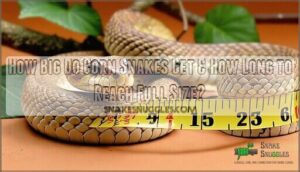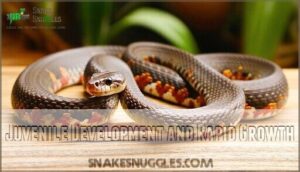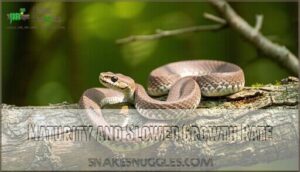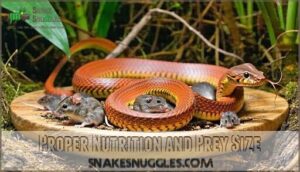This site is supported by our readers. We may earn a commission, at no cost to you, if you purchase through links.
 Your corn snake will reach 3.5 to 5 feet long as an adult, typically hitting full size by 2-3 years old.
Your corn snake will reach 3.5 to 5 feet long as an adult, typically hitting full size by 2-3 years old.
Hatchlings start at just 8-14 inches but grow rapidly during their first year, often tripling in size. Most experience peak growth between 3-12 months, then slow considerably as adults.
Females grow about 15-20% larger than males, and captive snakes often outsize wild ones due to consistent feeding and ideal conditions.
Genetics play the biggest role in determining how big your snake gets, but proper nutrition, temperature, and housing help them reach their full potential. Several key factors can dramatically influence your snake’s final size.
Table Of Contents
- Key Takeaways
- Average Size of Corn Snakes
- How Big Do Corn Snakes Get and How Fast?
- Growth Stages of Corn Snakes
- Factors Affecting Corn Snake Growth
- Growth Differences Between Males and Females
- Ensuring Healthy Growth and Full Size
- Frequently Asked Questions (FAQs)
- How long does a corn snake take to grow?
- How big do corn snakes get?
- What is the growth pattern of a male corn snake?
- How old do corn snakes get?
- How big is a 1 year old corn snake?
- At what age does a corn snake become an adult?
- Will corn snakes bite?
- Do corn snakes like to be held?
- What is the best habitat for corn snakes?
- How often should corn snakes be fed?
- Conclusion
Key Takeaways
- You’ll watch your corn snake grow from 8-14 inches as a hatchling to 3.5-5 feet as an adult, typically reaching full size within 2-3 years
- Your snake experiences rapid growth during the first year, often tripling in size, then growth dramatically slows after 18-24 months when they reach maturity
- You can expect females to grow 15-20% larger than males, with genetics playing the biggest role in determining your snake’s final adult size
- You’ll need to provide consistent feeding, proper temperatures (75-85°F gradient), and appropriate enclosure space to ensure your corn snake reaches its full growth potential
Average Size of Corn Snakes
You’ll be amazed at how quickly your corn snake transforms from a tiny hatchling into a full-sized adult.
Most corn snakes reach their impressive adult length of 3 to 5 feet within just 2 to 3 years, though genetics and care quality play major roles in determining their final size.
Adult Length and Weight Ranges
Your adult corn snake will typically measure between 3.5 and 5 feet long, weighing 500 to 900 grams.
Your adult corn snake will measure 3.5 to 5 feet long, weighing up to 900 grams at full size
Most captive adults stay under 5 feet, with exceptional specimens reaching 6 feet.
Adult corn snake size depends on genetics, sex, and care quality. Females consistently grow larger than males by 15-20%.
These snake size variations make corn snakes perfect for reptile enthusiasts seeking manageable pets.
Size Variations in Captivity Vs. Wild
Captive growth often outpaces wild size development in corn snakes. Your pet snake will likely reach its maximum potential more consistently than wild counterparts.
Environmental stability and regular feeding schedules promote ideal development, while wild snakes face food scarcity and harsh conditions that can stunt growth.
- Captive corn snakes typically reach 4-6 feet, while wild specimens average 3-4 feet
- Snake morphs and color patterns don’t affect size potential between captive and wild populations
- Habitat influence in captivity provides consistent temperatures and humidity for steady growth
- Wild corn snake size variations result from irregular prey availability and seasonal challenges
- Adult corn snake size differences of 1-2 feet commonly exist between captive and wild specimens
Understanding the growth rate factors is essential for providing the best care for your pet corn snake, and recognizing the impact of environmental stability and regular feeding schedules on growth.
Factors Influencing Maximum Size
Several key factors determine your corn snake’s maximum size potential.
Genetic Influence acts as the primary blueprint – parents’ sizes strongly predict offspring dimensions.
Environmental Impact through proper enclosure space affects growth, while Nutrition Effects from consistent feeding schedules maximize development.
Health Factors like parasites can stunt growth, and Hormone Role during maturity influences final measurements across different corn snake morphs.
| Factor Category | Impact on Size | Key Considerations |
|---|---|---|
| Genetics | High | Parent size, morph type |
| Nutrition | Moderate-High | Feeding frequency, prey size |
| Environment | Moderate | Temperature, humidity, space |
How Big Do Corn Snakes Get and How Fast?
Corn snakes reach their full adult size relatively quickly, typically achieving their maximum length within 2-4 years of age.
You’ll see the most dramatic growth during their first year when hatchlings can nearly double in size, growing from about 10-15 inches to around 20-30 inches by their first birthday.
Growth Timeline From Hatchling to Adult
Your corn snake’s journey from tiny hatchling to full-sized adult follows predictable growth phases that’ll amaze you. These development stages showcase remarkable size increase as your snake navigates its maturation process.
Here’s the corn snake length timeline:
- Hatchling stage (0-3 months): 8-14 inches, doubling size rapidly
- Juvenile phase (3-12 months): 20-35 inches, peak snake growth rate
- Sub-adult period (12-24 months): 35-48 inches, growth slowing
- Adult stage (2+ years): 36-60 inches, minimal further growth
Snake growth stages vary based on aging factors like genetics and nutrition, but this timeline helps you track your snake’s progress through these fascinating reptile growth stages with confidence. Understanding snake size factors is essential for providing the right care and environment for your pet.
Typical Age for Reaching Full Size
Between two and four years of age, most corn snakes reach their full adult size.
Your corn snake reaches full size surprisingly fast – just 2-4 years from tiny hatchling to impressive adult!
Growth Patterns show they’ll hit their maximum corn snake length around this timeframe, though Development Rate varies by individual.
Size Factors like genetics and feeding influence when they achieve Full Maturity.
Age Limits for growth typically cap at four years, when snake growth rate substantially slows.
After reaching full snake size, further growth becomes minimal throughout their corn snake lifespan.
Growth Stages of Corn Snakes
You’ll watch your corn snake transform through three distinct growth phases as it matures from hatchling to adult.
Understanding these stages helps you provide proper care and set realistic expectations for your snake’s development timeline.
Hatchling Size and Early Growth
When hatchlings emerge, they’re surprisingly small—measuring just 10 to 15 inches long.
These tiny neonates pack incredible growth potential, though neonate size can vary slightly within the corn snake species range.
Early feeding proves essential during this stage, as proper hatchling care directly impacts their growth rates.
You’ll notice these miniature serpents double their length within their first year, establishing important snake growth benchmarks.
This rapid early development sets the foundation for healthy juvenile development ahead.
Juvenile Development and Rapid Growth
During their first year, juvenile corn snakes experience explosive growth patterns, often doubling in size as their bodies adapt to regular snake nutrition.
This rapid expansion phase sees them grow from tiny hatchlings to substantial juveniles, reaching 20-30 inches by six months.
Their snake growth rate during these development stages is remarkable, with youth care focusing on frequent feeding to support this natural snake size variation within the corn snake lifespan.
Understanding proper breeding corn snakes techniques is essential for promoting healthy growth and development in these animals, considering their overall corn snake lifespan.
Maturity and Slowed Growth Rate
After rapid juvenile expansion, your corn snake’s growth patterns shift dramatically around 18-36 months.
Size limits become apparent as maturity signs emerge – reduced shedding frequency and decreased appetite signal slowdown triggers.
Adult care requires adjusting feeding schedules since snake size plateaus between 3-5 feet.
Snake growth practically stops, with snake length increases becoming minimal throughout their corn snake lifespan, though snake weight may fluctuate slightly.
Adult corn snakes require careful management, as their growth patterns and appetite change significantly over time.
Factors Affecting Corn Snake Growth
Your corn snake’s final size depends on several key factors you can influence.
Diet quality, genetics, and environmental conditions all play vital roles in determining whether your snake reaches its full growth potential.
Diet and Feeding Schedule
Your corn snake’s feeding schedule directly impacts its growth potential and overall size development.
Proper nutrition involves matching prey size to your snake’s body width while maintaining consistent meal frequency.
Here are four essential feeding guidelines for ideal growth:
- Hatchlings: Feed pinkie mice every 5-7 days during rapid early development phases
- Juveniles: Switch to larger prey with 5-7 day intervals as growth accelerates
- Adults: Provide appropriately sized mice every 7-10 days once maturity is reached
- Prey sizing: Choose rodents no larger than 1.5 times your snake’s widest body section
Nutrient balance from whole prey supports healthy digestion patterns, while overfeeding can cause regurgitation and stunted development.
A well-planned corn snake diet includes consideration of snake food options to guarantee proper nutrition.
Genetics and Sex Differences
Genetics play the starring role in determining your snake’s final size.
Males typically reach around 4.5 feet, while females average 3.5-4 feet – think of it as nature’s built-in size chart.
Heredity factors from both parents influence growth patterns and size variation substantially.
When choosing a corn snake, ask breeders about parent sizes to predict your future companion’s dimensions, considering heredity factors.
Environmental Conditions and Enclosure Size
Your snake’s environment shapes its growth potential more than you might expect.
Proper enclosure dimensions, temperature ranges, and humidity control create the foundation for healthy development.
Here are three critical environmental factors:
- Enclosure Design – Adult corn snake terrarium size should meet minimum snake enclosure size requirements of 40+ gallons with proper ventilation systems to prevent stunted growth
- Temperature Ranges – Maintain 75-85°F gradient with 88°F basking spot using automated thermostats for consistent metabolism and digestion
- Humidity Control – Keep 50-60% humidity during shedding cycles while ensuring adequate lighting options and air circulation for respiratory health
Growth Differences Between Males and Females
When you’re planning for a corn snake, you’ll notice that males and females grow differently in both size and timing.
Male corn snakes typically reach around 4.5 feet in length, while females usually max out at 3.5 to 4 feet.
Females tend to be heavier and more robust overall, though their length is generally less than that of males.
Size and Weight Comparison
When examining corn snake size differences, you’ll notice distinct variations between males and females.
Males typically reach around 4.5 feet in length, while females average 3.5-4 feet.
These Size Factors create noticeable Length Ratios in adult snakes.
| Characteristic | Males | Females |
|---|---|---|
| Average Length | 4.5 feet | 3.5-4 feet |
| Weight Range | 1.5-2 pounds | 1-1.5 pounds |
| Body Thickness | Slender build | Wider girth |
This Weight Comparison reflects natural dimorphism in corn snake development.
Growth Patterns and Rate Variations
Males typically reach sexual maturity around 18 months, while females mature closer to 24-36 months.
Growth spurts occur differently between sexes—males often experience faster initial growth but plateau earlier.
Environmental impact and feeding strategies affect both equally, though size genetics determine males average 4.5 feet versus females at 3.5-4 feet.
Snake growth benchmarks show males achieve snake length milestones quicker initially, with faster initial growth and size genetics playing a role.
Ensuring Healthy Growth and Full Size
You’ll maximize your corn snake’s growth potential by providing consistent, proper care throughout their development stages.
The right nutrition, environment, and health monitoring guarantee they reach their full adult size of 3-5 feet within 2-3 years, which is crucial for their overall development.
Proper Nutrition and Prey Size
Through proper prey selection and feeding frequency, you’ll release your corn snake’s full growth potential.
Nutrient balance directly impacts how efficiently your snake reaches adult size.
Follow these snake feeding tips for maximum growth:
- Meal size should match 1.5x your snake’s mid-body width
- Feed hatchlings weekly, adults every 2-3 weeks
- Rotate between mice, rats, and occasional chicks
- Monitor digestion rate – adjust portions if regurgitation occurs
These reptile nutrition facts guarantee your corn snake hits proper snake growth benchmarks through balanced snake diet recommendations.
Understanding the proper feeding practices is vital for a healthy corn snake.
Temperature and Humidity Management
Maintaining proper thermal gradients and humidity levels creates the foundation for healthy growth.
You’ll need a temperature gradient from 75-85°F, with heat sources providing controlled warmth.
Temperature control guarantees efficient digestion, while moisture management at 40-60% humidity supports proper shedding and overall health.
Effective temperature management relies on a good temperature controller system.
| Parameter | Ideal Range | Growth Impact |
|---|---|---|
| Basking Temperature | 85-88°F | Aids digestion |
| Cool Side Temperature | 75-78°F | Prevents stress |
| Humidity Level | 40-60% | Supports shedding |
The key to successful growth is maintaining the right temperature and humidity levels, which involves creating a suitable environment with a temperature gradient and ensuring proper shedding through effective moisture management.
Regular Health Checks and Monitoring
You’ll want to schedule annual veterinary care with an exotic animal specialist who understands snake health issues.
Regular health monitoring includes tracking weight, measuring growth against snake growth benchmarks, and watching for signs of illness.
Good snake hygiene and parasite control prevent many problems.
Document feeding responses, shedding cycles, and behavioral changes to catch health concerns early and guarantee healthy development.
Maintaining a proper snake health checklist is vital for identifying potential issues and ensuring the well-being of your corn snake.
Frequently Asked Questions (FAQs)
How long does a corn snake take to grow?
Corn snakes reach full size between two to three years old. They grow rapidly during their first year, often doubling in length, then growth slows substantially after maturity.
How big do corn snakes get?
Adult corn snakes typically reach 3-6 feet long and weigh 1-2 pounds.
You’ll see them hit their full size by 2-4 years old, with genetics and care quality determining their final dimensions.
What is the growth pattern of a male corn snake?
Male corn snakes follow a predictable growth trajectory.
They’ll reach around 20-30 inches by six months, then 35-40 inches by their first birthday.
By maturity at three years, males typically average 5 feet in length, slightly larger than females, with males being the focus of this growth pattern.
How old do corn snakes get?
Like fine wine aging in a cellar, you’ll find corn snakes can live surprisingly long lives.
In captivity, they typically reach 15-20 years with proper care, though some exceptional individuals have lived over 23 years.
How big is a 1 year old corn snake?
By your snake’s first birthday, you’ll have a juvenile measuring around 35-40 inches long. That’s roughly three feet of slithering buddy who’s tripled in size from their tiny hatchling days!
At what age does a corn snake become an adult?
Most corn snakes reach sexual maturity around 2-3 years old, marking their passage to adulthood.
You’ll notice they’ve reached full size by this point, typically measuring 3-5 feet long and weighing around 2 pounds, which can be considered a complete sign of their growth.
Will corn snakes bite?
Yes, corn snakes can bite, but they’re extremely docile and rarely do.
They’d much rather escape than fight.
Defensive bites feel like pinpricks—no venom, minimal pain.
Proper handling makes bites unlikely.
Do corn snakes like to be held?
Ironically, these "docile" snakes don’t exactly crave your cuddles. Corn snakes tolerate brief handling but aren’t naturally affectionate pets. They’ll endure gentle sessions but prefer being left alone to explore.
What is the best habitat for corn snakes?
You’ll want a 40-gallon long terrarium with secure ventilation, warm and cool zones (78-85°F basking, 70-75°F cool side), hiding spots on both ends, and clean water available.
How often should corn snakes be fed?
Feeding your corn snake shouldn’t be rocket science, but getting it wrong can spell disaster.
Adults need meals every 1-2 weeks, while juveniles eat weekly and babies require feeding every other day for proper growth.
These feeding schedules are crucial for the health and development of your corn snake.
Conclusion
You’ve just become an expert on corn snake dimensions – surely the most pressing knowledge for modern survival.
Understanding how big do corn snakes get and how long does it take for them to grow helps you provide proper care throughout their development.
Your snake’s final size depends on genetics, but consistent feeding and ideal temperatures guarantee healthy growth.
Most reach full size by three years, with females growing larger than males, and it’s essential to monitor growth patterns and adjust care accordingly for best results.
- https://www.google.com/search?client=safari&sca_esv=51537aeedf813448&rls=en&q=molting&sa=X&ved=2ahUKEwi-q5GF662OAxUYTDABHc00H8IQxccNegQIOBAB&mstk=AUtExfCLAVdaLIOfvk9hE9Hi5t8Ek0TS6H_ECZayx3omhNj6IhUbMXPs__9dek0LmZBvnzT0NuP9YN1LDUoj1OtzsKd0EPKXSrNs3Qeyje3VtnLIq6tg7Xw-KVs-6fixRfFiYd4&csui=3
- https://image.petmd.com/files/2024-12/1730300-24-10-PMD-CornSnakeCareSheet.pdf?VersionId=C85M2VWn84MucQ1nerMeMYFQ3gfu0JZS?utm_source=petmd.com&utm_campaign=caresheet&utm_medium=PDF
- https://www.reptifiles.com/corn-snake-care-guide/corn-snake-accessories-decor/
- https://cornsnake.net/pages/feeding
- http://www.thecornsnake.co.uk/forum/topic.asp?TOPIC_ID=27833















